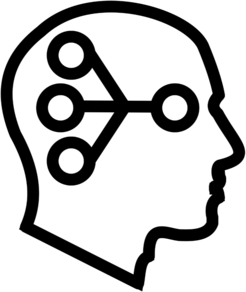Threat Avoidance Group
The Threat Avoidance Group was active until October 2023. Dominik Bach is now Hertz Chair for Artificial Intelligence and Neuroscience at the University of Bonn, Germany.

Our mission is to unpack the parallel computing structure of the human mind, how this software architecture is implemented in the brain, and where it fails in mental illness. We bring the mind to its computational limits by putting it in its natural environment, where it needs to cope with survival threats. Avoidance actions in the absence of real threat are a hallmark of several psychiatric conditions, such as anxiety disorder or post-traumatic stress disorder. We seek to unpack the underlying mechanisms and develop novel treatments. Our framework is based on the key idea of multiple controllers: systems that flexibly deal with limited parts of the environment, and compete for action output. Collectively, these systems can perform approximate Bayesian decision making. To probe these systems, we bring the mind into those niches of the environment that require forecasting threat and responding to it. Experimentally, this approach is based on virtual reality, serious games, and associative learning. We combine computational modelling with behavioural assays, neuroimaging and pharmacological intervention. In order to facilitate translation into clinical practice, we are testing a range of candidate treatments in laboratory models of psychiatric disorders, for example with synaptic plasticity-inhibiting drugs, transcranial magnetic stimulation, and by optimised psychotherapy.
Key References
Bach, D. R., Tzovara, A., & Vunder, J. (2018). Blocking human fear memory with the matrix metalloproteinase inhibitor doxycycline. Molecular Psychiatry, 23(7), 1584-1589. doi:10.1038/mp.2017.65
Korn, C. W., & Bach, D. R. (2018). Heuristic and optimal policy computations in the human brain during sequential decision-making. Nature Communications, 9(1), 325. doi:10.1038/s41467-017-02750-3
Bach, D. R., & Dayan, P. (2017). Algorithms for survival: a comparative perspective on emotions. Nature Reviews Neuroscience, 18(5), 311–319. doi:10.1038/nrn.2017.35
Korn, C. W., Vunder, J., Miró, J., Fuentemilla, L., Hurlemann, R., & Bach, D. R. (2017). Amygdala Lesions Reduce Anxiety-like Behavior in a Human Benzodiazepine-Sensitive Approach–Avoidance Conflict Test. Biological Psychiatry, 82(7), 522–531. doi:10.1016/j.biopsych.2017.01.018
Bach, D. R. (2015). Anxiety-Like Behavioural Inhibition Is Normative under Environmental Threat-Reward Correlations. PLOS Computational Biology, 11(12), e1004646. doi:10.1371/journal.pcbi.1004646
